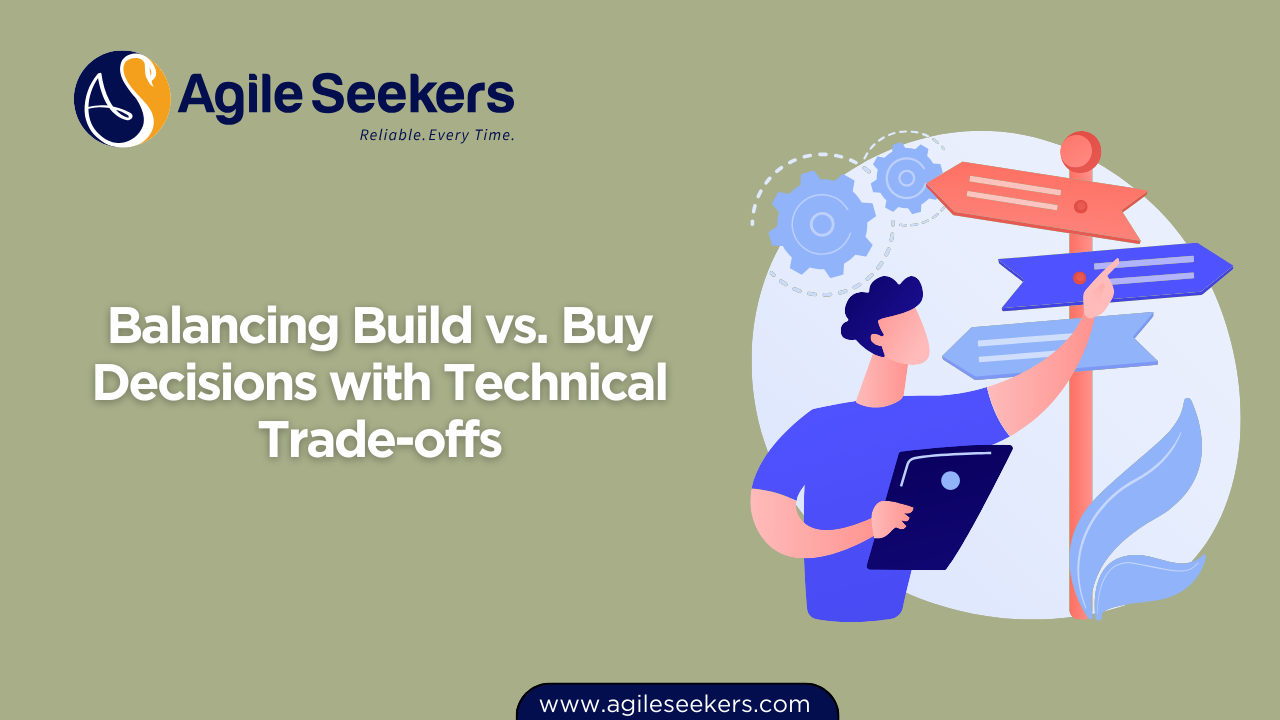Balancing Build vs. Buy Decisions with Technical Trade-offs

Every product team, at some point, hits a fork in the road: Should we build this capability in-house or buy a solution? While it might sound like a simple question, the real challenge lies in balancing technical trade-offs with strategic goals, budget, team capacity, and future flexibility. Making the right call requires clear evaluation, especially in platform and product-driven environments.
This article explores how to approach build vs. buy decisions with a structured lens, considering engineering complexity, long-term ownership, scalability, and alignment with business objectives.
Why Build vs. Buy Is Not Just a Technical Question
On the surface, the build vs. buy decision might appear purely technical, but it's deeply strategic. When product managers and architects debate this, the impact often extends far beyond code—affecting time-to-market, vendor lock-in, operational risk, and future product roadmap decisions.
Making informed decisions here is crucial, especially if you're pursuing structured frameworks like the SAFe POPM Certification, where cross-functional alignment and incremental delivery are key principles.
Build: When Customization and Control Are Priorities
Choosing to build means your team takes full ownership of architecture, development, and maintenance. This is ideal when:
- The functionality is core to your product’s unique value proposition.
- You need full control over performance, customization, or security.
- Existing solutions don’t offer the depth or integration you require.
Advantages:
- Tailored solution aligned to your domain needs
- Full control over roadmap, updates, and integrations
- No vendor dependency or license costs
Risks:
- Longer time to deliver
- Greater demand on internal resources and engineering bandwidth
- Ongoing maintenance and technical debt
Buy: When Speed, Stability, and Scale Matter
Buying third-party tools or platforms often makes sense when time-to-market and proven functionality matter more than customization.
Advantages:
- Faster implementation
- Enterprise-grade scalability, security, and support
- Reduced burden on engineering teams
Risks:
- Vendor lock-in
- Limited customization options
- Ongoing licensing and subscription costs
This trade-off becomes especially important in roles guided by SAFE Product Owner Certification, where backlog prioritization and delivery value must be managed effectively under constraints.
Key Technical Trade-offs to Consider
Regardless of whether you build or buy, the decision comes with clear technical trade-offs. Here are some of the most critical dimensions to evaluate:
1. Integration Complexity
Third-party tools can come with APIs or plugins—but integration into your existing system architecture may still require effort. Custom-built solutions allow native integration, but that can cost more in the short term.
2. Scalability & Performance
Vendor solutions often have proven scalability patterns. But when scale is part of your competitive advantage, building your own system might give you better control and fine-tuning opportunities.
3. Maintenance Overhead
Building internally means you're also responsible for fixing bugs, security updates, performance improvements, and infrastructure. This adds long-term overhead your team must plan for.
4. Total Cost of Ownership (TCO)
Initial purchase costs can mislead. While building seems expensive upfront, subscription and renewal fees for vendor solutions often add up. Evaluate long-term costs, not just CapEx vs. OpEx.
For project leads following PMP certification training, incorporating such analysis into procurement and planning documents becomes essential.
5. Innovation Velocity
When speed of experimentation is a priority, off-the-shelf tools may hinder quick pivots. Custom builds can offer agility—but at the cost of delivery velocity. The trick is finding the balance that fits your roadmap.
Strategic Questions to Ask Before Deciding
Use the following questions to evaluate each option through a product and engineering lens:
- Is this capability core to our differentiation in the market?
- Can we deliver it internally within the needed timeline?
- What is the opportunity cost of dedicating internal resources?
- How frequently will the requirements change?
- Does the vendor offer data portability and open standards?
Case Example: Internal Analytics Platform
Let’s say your product team needs a real-time analytics dashboard. Off-the-shelf solutions like Segment or Mixpanel offer rich features, pre-built integrations, and time savings. But if your product needs deep, domain-specific analytics (e.g., within a healthcare platform), you might benefit from building your own for tighter compliance, integration, and customization.
Teams certified through programs like the SAFe Popm training often evaluate such decisions through the lens of Lean Budgeting and Feature Enablers.
Mitigating Risk Through a Hybrid Approach
In many cases, the best approach is hybrid. For instance, buy the foundational technology (e.g., an authentication provider like Auth0) and build domain-specific workflows and UIs on top of it. This provides the speed of adoption with the flexibility of control.
Hybrid also works well when prototyping or during early MVP phases. Buy fast, validate assumptions, and then consider building your own if scale or control become limiting factors.
Stakeholder Alignment Matters
Ultimately, the build vs. buy call is not made in isolation. Stakeholders from engineering, security, product, legal, and finance all weigh in. One common failure pattern is making the decision in a silo, leading to downstream friction during implementation.
Professionals trained under Project Management Professional certification frameworks know the importance of stakeholder mapping and communication planning. These disciplines help ensure long-term alignment and reduced rework.
Checklist for Decision-Making
Use this practical checklist during your evaluation process:
- Define strategic importance of the functionality
- Estimate development effort vs. vendor integration
- Run TCO analysis over 3–5 years
- Evaluate scalability and performance needs
- Check vendor SLAs, support, roadmap, and exit options
- Consider future roadmap flexibility and team dependencies
Conclusion
Build vs. buy decisions are common—but they’re rarely easy. It’s not just a matter of engineering effort. It’s a question of strategic alignment, technical fit, long-term ownership, and team velocity. By analyzing trade-offs holistically and aligning with your business goals, you can make decisions that scale with your product and organization.
For those navigating such decisions often, pursuing structured certifications like PMP training or SAFE Product owner/Manager certification provides frameworks that bring rigor to these conversations.
Also read - Structuring OKRs for Technical Product Teams
Also see - Tracking Technical Debt Using Product KPIs




















